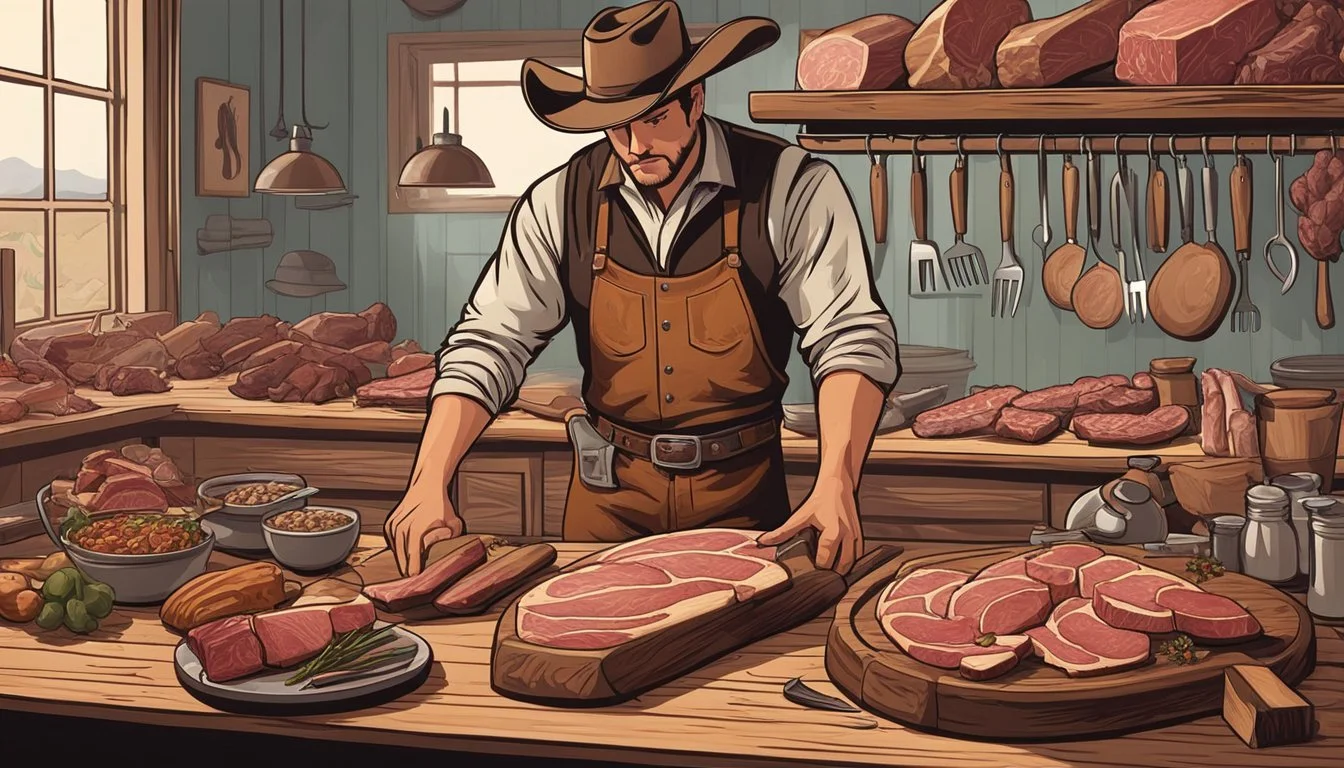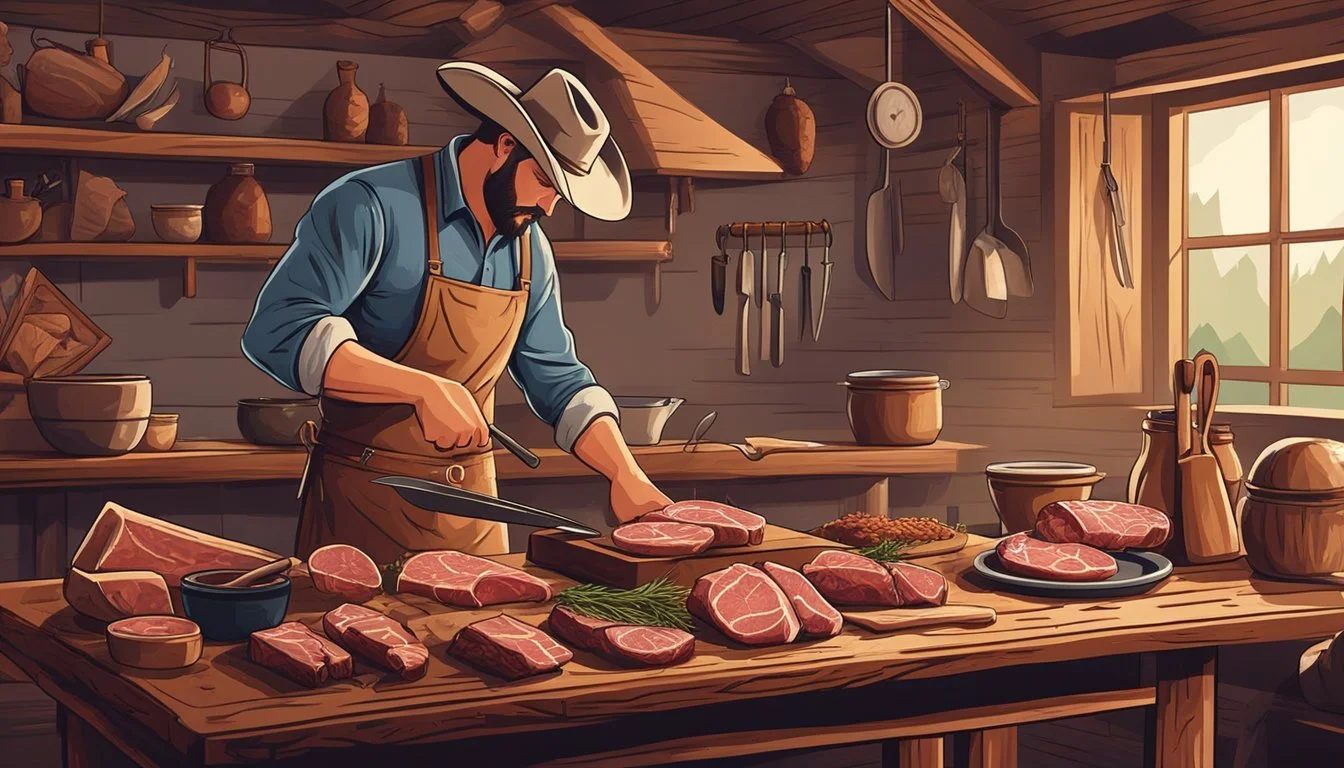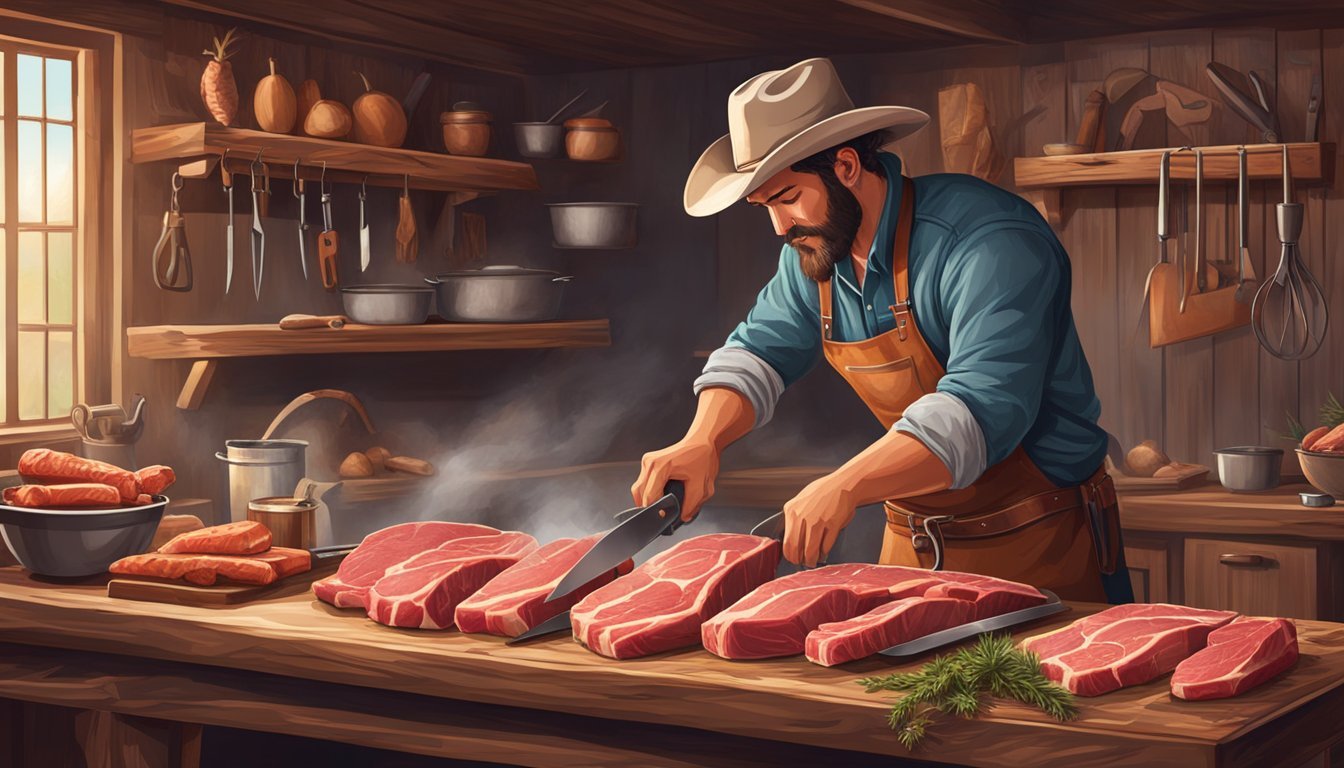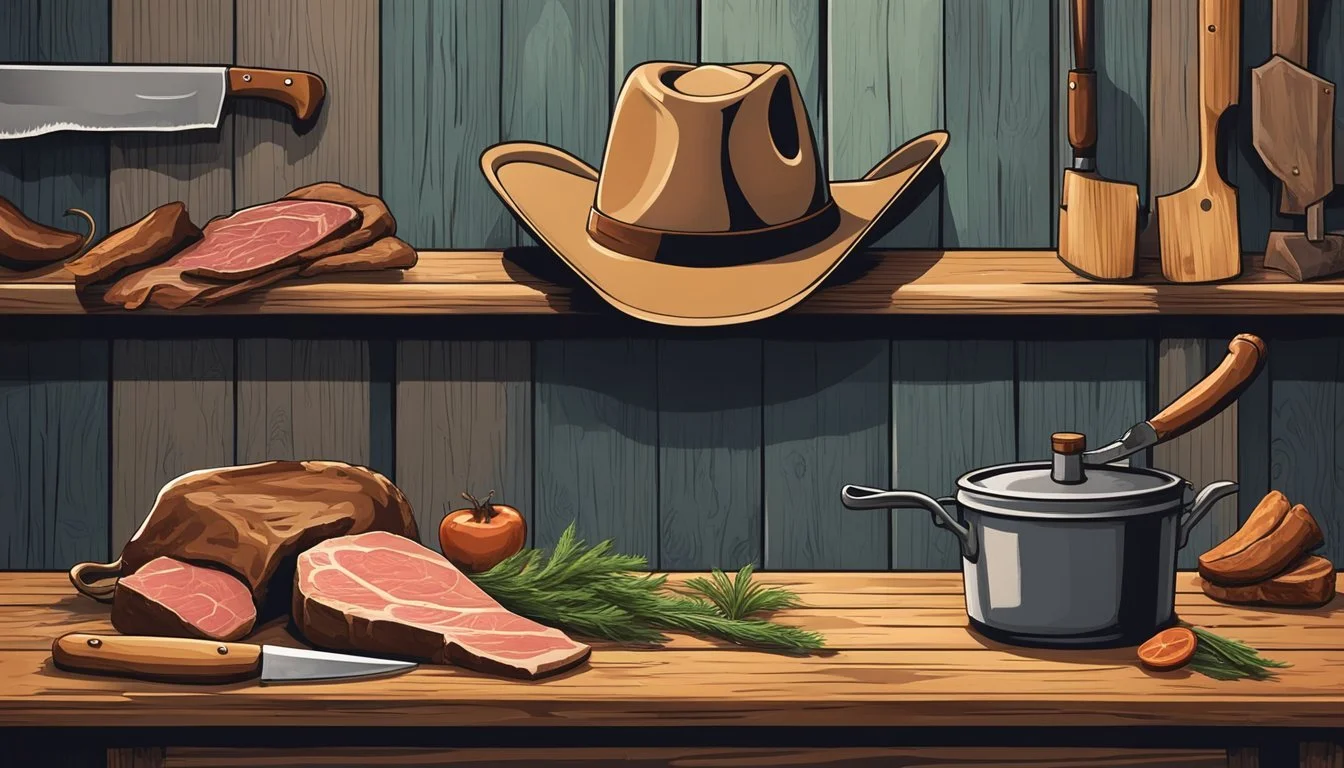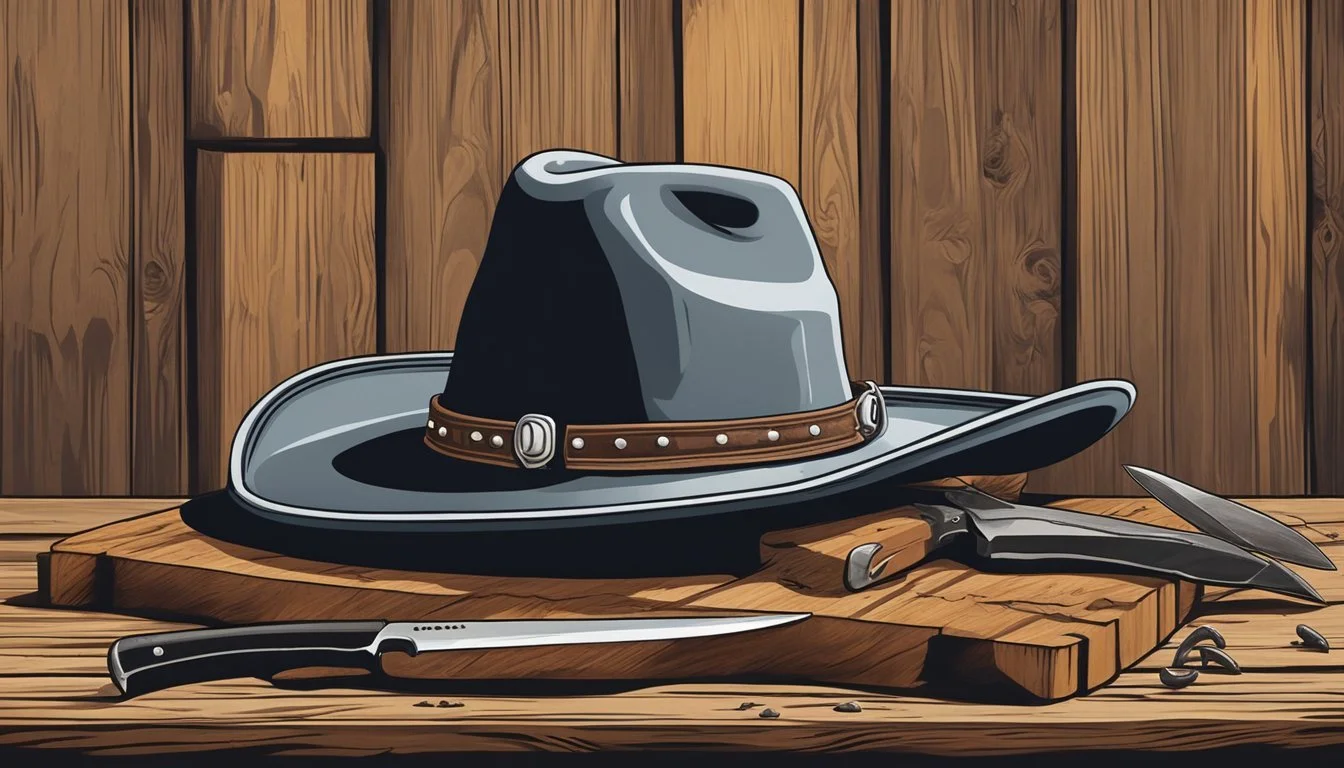The Art of Butchery
Cowboy Techniques for Masterful Meat Preparation
Butchery is a time-honored craft that demands precision, understanding, and respect for the meat being prepared. Rooted in tradition, it is a skill that cowboys and ranch hands historically had to learn in order to make the most of their livestock. These craftsmen approached butchery not just as a necessary task, but as an art form that celebrated the value and utility of every part of the animal. The education in meat preparation techniques provided by seasoned butchers reflects a deep-seated appreciation for the trade, transforming a simple cut of meat into a culinary delight.
Cowboy butchers often operated with an intimate knowledge of the animals, combining their practical experience of livestock management with butchery. The art of butchery, particularly in the cowboy tradition, required attention to detail and a methodical approach to breaking down an animal. Their techniques ensured that nothing was wasted, reflecting an intense connection to the land and resources.
Today, these time-tested practices continue to influence modern butchery. As an art form that has evolved over centuries, contemporary meat cutting still honors the legacy of these skilled artisans. The expert hands of a butcher seamlessly weave together tradition and technique, demonstrating how the craft has grown while still paying homage to its roots.
Understanding Butchery Fundamentals
In mastering the art of butchery, especially within the cowboy tradition, one needs to appreciate the blend of history, skills, and precision. This section aims to equip readers with key insights into the fundamental aspects of butchery.
History and Evolution of Butchery
Butchery has its roots in the dawn of human civilization, embodying both a craft and a survival skill. The evolution from primitive stone tools to advanced equipment marks the progress from simple survival to an expression of culinary artistry. Butchers have honed their craft over centuries, leading to the efficient and sustainable practices seen today that respect the "nose to tail" philosophy.
Basic Butchery Terminology
Familiarity with terms is crucial for any aspiring butcher. The beef carcass is initially divided into primal cuts, which are large sections like the chuck, rib, and loin. These are then broken down into subprimal and smaller retail cuts. Mastery of this language ensures precise communication and accurate meat processing.
Anatomy Knowledge for Butchers
Understanding animal anatomy, including muscles and connective tissue, is a foundational element of butchery. This knowledge enables butchers to navigate the carcass, identifying the ideal cuts while minimizing waste and ensuring the highest quality of meat reaches the consumer.
The Importance of Meat Quality
Quality meat begins with sourcing from reputable suppliers. Characteristics such as marbling and color indicate the meat's quality, directly impacting flavor and tenderness. Butchers play an integral role in this process, as their craftsmanship determines the final product's quality.
Tools of the Trade
The butcher's tools are an extension of their skilled hands. Essential equipment includes:
Knives: from versatile boning knives to sturdy cleavers.
Sharpening tools: maintaining a keen edge through regular honing.
Refrigeration: to keep meat at optimal temperatures.
Scales: for accurate measurement.
Proper use and maintenance of these tools are fundamental to the butchery process.
Health and Safety Practices
Adherence to health and safety is paramount. This includes maintaining cleanliness in the butchery environment, following strict regulations, and ensuring all cutting tools are used in a manner that minimizes risk. Responsible butchers prioritize their own safety and that of their customers by upholding these standards.
Essential Cutting Techniques
Mastering essential cutting techniques is imperative in the art of butchery. It allows for precise meat preparation, ensuring optimal flavor and texture. Each technique requires a steady hand, a sharp knife, and an understanding of the meat's structure.
Basic Slicing and Dicing
An adept butcher begins with basic slicing and dicing, developing their dexterity to produce uniform cuts. They maintain a rhythmic motion to create even slices, which is crucial for cooking consistency. A combination of horizontal and vertical cuts yields perfect dices, often used in stews and braises.
The Art of Primal Cuts
Identifying and executing primal cuts is a foundational skill. This involves separating the beef carcass into primary sections such as the chuck, rib, loin, and round. Precision is key, as it affects the quality and type of the final product, be it savory roasts or succulent steaks.
Breaking Down Subprimals
After processing primary sections, butchers focus on breaking down subprimals. This step involves further dividing primal cuts into more manageable pieces. For example, the loin can lead to a tender tenderloin, while the chuck can be sectioned into flat iron steaks, each cut marked by skilled hand-crafting.
Deboning and Trimming Skills
Deboning and trimming are meticulous skills that enhance the meat's presentation and edibility. Butchers carefully remove bones and excess fat, retaining only what will enhance flavor. Removing silver skin without damaging the meat ensures a tender eating experience.
Specialty Cuts and Preparations
Finally, butchers may perform specialty cuts and preparations. These include culturally and regionally specific cuts or those suited for certain cooking methods. Ribs prepared for barbecuing, or a prime rib and ribeye meticulously trimmed, demonstrate the height of the butcher's craft.
Specialized Meat Types Preparation
Preparing specialized meats involves precise techniques and understanding each type’s unique characteristics in order to preserve flavor and tenderness.
Working with Beef
When handling beef, one must pay attention to the specific cut being prepared. Sirloin and flank steaks, popular for their rich flavor and versatility, are best when cooked to medium rare, allowing their inherent qualities to shine. Table 1 outlines recommended preparations for common beef cuts.
Table 1: Beef Cut Preparations
Cut Preparation Technique Cooking Method Sirloin Marinated for tenderness Grilled or Broiled Flank Scored to enhance flavor uptake Marinated, then Grilled or Broiled Ground Beef Seasoned or spiced Used in patties for Grilling or Cooking
For ground beef, a higher fat content can enhance taste and juiciness, making it preferable for hamburgers and meatloaves.
Chicken Butchery Techniques
Chicken butchery necessitates a different set of skills, focusing on minimizing waste and maintaining meat integrity. The key is a sharp knife and an understanding of the bird’s anatomy. Breasts are best removed by slicing close to the carcass, while wings and thighs are disjointed at their connecting joints. To keep chicken juicy during cooking, brining can be an effective technique.
Approaches to Lamb and Pork
Lamb requires a delicate touch, with cuts like chops needing quick cooking methods to prevent toughness.
Lamb Chops (What wine goes well with lamb chops?): Quick sear on high heat.
Pork, on the other hand, offers a broad range of products, from bacon to roasts. Pork should be cooked to an internal temperature of 145°F to ensure safety while maintaining moisture. Bacon, with its high fat content, is best cooked slowly to render out fat and ensure a crispy finish.
Pork Belly for Bacon: Cured, then slow-cooked or smoked.
Diverse from one another, each meat type in butchery demands a specific approach to emphasize its unique qualities and attain the best culinary experience.
Cooking and Preparation Methods
The art of butchery encompasses an array of techniques to enhance flavor and tenderness in meats. Mastering these methods allows cooks to prepare meat in ways that are both traditionally rustic and elegantly modern.
Selecting Cooking Methods
Choosing the right cooking method is crucial for bringing out the unique qualities of different cuts. For instance, slow-roasting is ideal for tougher cuts such as brisket or chuck roast, as it tenderizes the meat over time. On the other hand, tender, high-quality cuts like filet mignon are best suited for quick, high-heat methods like grilling or pan-searing to form a delicious crust while keeping the interior moist.
Roasting: Best for larger, tougher cuts.
Grilling: Ideal for high-quality, tender cuts.
Prepping Meat for Cooking
Proper preparation before cooking can greatly influence the tenderness and flavor of the meat. Brining or marinating can infuse the meat with moisture and taste, while tying a roast ensures even cooking and preserves its shape during the cooking process.
Brining: Soaking in a saltwater solution to add moisture.
Marinating: Coating in a flavorful liquid to enhance taste.
Tying: Using butcher's twine to hold the shape of roasts.
Creating Delicious Charcuterie
Charcuterie (What wine goes well with charcuterie?) involves the curing and smoking of meats to create an array of delicacies such as salamis, hams, and pâtés. The slow process of curing draws out moisture, concentrating flavor, while smoking adds a distinctive woodsy aroma and taste.
Curing: Salt-based preservation, crucial for long preparation processes.
Smoking: Infuses smoky flavor, often pairing with curing.
Grinding Meat for Sausage and Burgers
The grinding process is essential for making sausages and burgers. It is critical to use well-chilled, high-quality ground beef or venison (What wine goes well with venison?) to prevent fat from smearing. Consistent grinding yields a better texture and flavor distribution in the final product.
Coarse Grind: For a more rustic sausage texture.
Fine Grind: Preferred for smoother patties and emulsified sausages.
Crafting Gourmet Burgers
Creating a gourmet burger becomes an artisanal process when incorporating high-quality, freshly ground beef. The key is balancing fat content for juiciness without overpowering the rich, meaty flavor. Expertly seasoning and minimal handling of the patties contribute to forming the perfect crust when cooking.
Fat Content: Aim for around 20-30% for optimal juiciness.
Seasoning: A precise blend enhances, not masks, the beef's natural flavors.
Advanced Butchery Practices
In the world of butchery, the cowboy approach embraces a blend of time-honored skills and modern techniques. Here, we zero in on how butchers make every cut count, utilizing the entire animal in an ethical and sustainable manner.
Whole Animal Butchery
Whole animal butchery is a skillful practice where butchers utilize the entire carcass, minimizing waste and honoring the animal. This method, more prevalent in specialty butcher shops, requires comprehensive knowledge about various cuts and a high level of precision. They dissect an animal into primal cuts like the beef rib and plate, managing every part with care.
The Nose-to-Tail Philosophy
Nose-to-tail butchery is a philosophy underpinning the practice of using all parts of the animal, including offal. It exemplifies sustainable practices within the meat industry, ensuring that butchers extract maximum value from the carcass. Engaging in this philosophy often necessitates educating consumers about the array of flavors and textures offered by unconventional cuts.
Making Use of Lesser-Known Cuts
Butchers are adept at identifying and promoting lesser-known cuts which are often overlooked, such as sirloin cap or flank steak. They introduce these options to customers, illuminating their culinary potential and encouraging more diverse utilization of the meat. This approach reduces waste and fosters more sustainable consumption patterns.
Innovations in Meat Curing
The evolution of butchery is evident in the area of meat curing, where traditional practices like making bacon have merged with innovative techniques. Modern charcuterie involves a variety of curing methods, from simple salting to intricate fermentation processes. Butchers today aim to enhance flavor and longevity of meats, while also keeping up with consumer demands for quality and variety.
With these practices in play, butchers across the globe are continuously contributing to a more responsible and thoughtful meat industry.
The Business of Butchery
The business of butchery merges traditional craftsmanship with modern retail operations, requiring butchers to be skilled in customer service, education, and sustainable meat sourcing practices.
Running a Successful Butcher Shop
A successful butcher shop hinges on a combination of business acumen and butchery expertise. Owners must understand both the retail and the operational aspects of the business, from stock management to financial planning. Maintaining high standards of cleanliness and organization within the shop is critical to ensure compliance with health regulations and to foster a professional environment that customers trust.
Retail Operations: Efficiently managing inventory, pricing, and merchandising.
Customer Service: Building rapport and ensuring repeat business through excellent service.
Craftsmanship: Demonstrating cutting skills that minimize waste and maximize product offering.
Educating Customers on Meat Selection
Butchers play a pivotal role in guiding customers through meat selection, offering insights on different retail cuts and their preparation. They educate consumers on how to distinguish various meat qualities and what cuts are best suited for specific recipes or cooking methods. Providing this level of education enhances customer experience and can differentiate a butcher shop from its competitors.
Education: Offering workshops or one-on-one guidance on choosing and preparing meat.
Customer Engagement: Creating informative signage and brochures for customers to take home.
Sourcing and Sustainability
In today's market, consumers are increasingly interested in the sourcing and sustainability of their meat. Butcher shops that prioritize transparent sourcing from local farms and practice whole-animal butchery are often more attractive to conscious consumers. Implementing sustainable practices not only supports local ecosystems and reduces waste but also appeals to a growing demographic concerned with ethical consumption.
Sourcing: Building relationships with local farmers and purveyors.
Sustainable Practices: Emphasizing nose-to-tail butchery to utilize the entire animal.
Closing Thoughts
The tradition of butchery evokes images of skilled artisans, employing both time-honored and innovative techniques to carve meats. Cowboy butchery is steeped in this rich heritage, showcasing not only a rugged, hands-on approach to meat preparation but also a deep respect for the animal. It's a practice that connects the past to the present, bridging generations of meat preparation methods.
One cannot discuss cowboy butchery without acknowledging the significance of its role in sustainable practices. As society becomes increasingly aware of the environmental impact of meat consumption, the methods of cowboy butchery—with its focus on using every part of the animal—align closely with current sustainable trends.
Tradition Sustainable Trend Whole-animal butchery Minimal waste philosophy Hand-crafted cuts Tailored meat selection
Looking to the future, an artisanal wave within the culinary arts suggests that cowboy butchery may adapt further, melding traditional foundations with modern demands. Though the tools and techniques may evolve, the essence of butchery remains unchanged: precision, respect for the meat, and a commitment to quality.
Butchery, particularly within the cowboy ethos, persists as a testament to culinary artistry. They do not simply process meat; they honor a time-honored craft. Their trade, far from fading, is poised for a renaissance as it embraces both its roots and the directions of the future.

